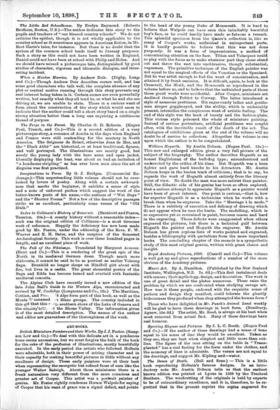ART-BOOKS.
British Miniature Painters awl their Works. By J. J. Foster. (Samp- son Low and Co.)—To deal with this delicate art in a ponderous tome seems anomalous, but we must forgive the bulk of the book for the sake of the profusion of illustrations, mostly beautifully executed. In the early period the artists who followed Holbein were admirable, both in their power of seizing character and in their capacity for making beautiful pictures in little without any smallness of design. These early painters were at their best when representing the energetic but refined faces of men like the younger Walter Raleigh. About these miniatures there is a frank naturalism very different from the more conscious and greater art of Cooper. This artist was a portrait painter of genius. Mr. Foster rightly condemns Horace Walpole for saying of Cooper that his want of grace was a signal defect, and points
to the head of the young Duke of Monmouth. It is hard to believe that Walpole can have seen this inimitably beautiful boy's face, or he could hardly have made so fatuous a remark. This splendid specimen from the Queen's collection is, like so many of Cooper's works, unfinished in unimportant parts. It is hardly possible to believe that this was not done purposely. It was a form of impressionism, a method of concentrating attention on the face. Titian and Velasquez could so play with the focus as to make whatever part they chose stand out and throw the rest into unobtrusive, though substantial, vagueness. The primitive technique of the English painter was not equal to the magical effects of the Venetian or the Spaniard. But he was artist enough to feel the want of concentration, and attained it by frank omission. It is difficult, again, to look at the Cromwell, the Monk, and the Monmouth as reproduced in the volume before us, and to believe that the unfinished parts of these three great works were accidental. After Cooper, miniature art declined through Petitot to Cosway. The latter introduced a style of nauseous prettiness. His sugar-candy ladies and gentle- men simper goggle-eyed, and the ability, which is undeniably present, intensifies the conspicuous want of artistic feeling. The end of this style was the book of beauty and the fashion-plate. This vicious style poisoned the whole of miniature painting. Instead of serious portraiture, artificial prettiness was sought after, with the inevitable result of the death of the art. The catalogues of exhibitions given at the end of the volume will no doubt be of service to collectors. Altogether the volume is one upon which the author is to be congratulated.


































 Previous page
Previous page